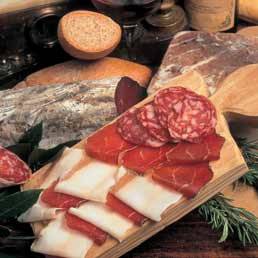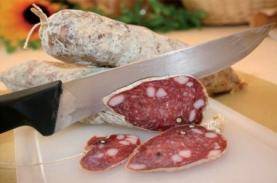The Ban Has Been Lifted: Welcome New Italian Salumi
For years travelers coming from Italy tried to smuggle salumi (cured meat products predominantly made from pork ) past airport officials. Just last week, at JFK, I personally witnessed someone being stripped of the tiny cacciatorini (small, dry-cured salami) that had been hidden in the suitcase. Yes, back in May a ban on the import of Italian Salumi has been lifted but no, the ban will not ease this. Products are still not allowed in personal baggage.
Presently, only about half of Italy’s wide variety of cured meat products are approved for import into the United States, according to the Italian Association of Meat and Salumi (ASSICA). “Up until now, we could only export seasoned ham, like Parma and San Daniele, cooked ham (Prosciutto Cotto) and mortadella,” said Davide Calderone, the association’s director. But things are changing.
As of May 28, a 40-year ban on the import of Italian Salumi has been lifted: USDA APHIS (Animal and Plant Health Inspection Service) has officially recognized the regions of Lombardy, Emilia-Romagna, Veneto, Piedmont, Friuli Venezia Giulia, Liguria, Marche, Valle d'Aosta and the provinces of Trento and Bolzano, free from swine vescicular disease, giving green light to short maturation Italian Salumi export in the USA. This is an historic event, considering the 15-year negotiation process involved.
The path to achieve this result was very complex and required a strong team action among the Italian Embassy in Washington, the Italian Ministry of Health, ASSICA and the European Commission. So far, it is not clear when Italian producers will be able to export recently liberalized products to the US, but many of them should be ready to make it happen by the end of 2013. What Italy knows for sure is that the potential meat exports increase from Italy to the USA should be at least 15%.
ASSICA and IVSI will continue to work hard, together with Italian and US institutions, to make sure that the result obtained will be actually implemented, so that there will be no impediments to the US access of Italian Salumi from the regions that have already been liberalized.
Calderone is hopeful that the US ban will be lifted in other regions, noting that the European Union has determined that nearly all of Italy is free of the disease. He is also hoping that the ban on Italian beef products will be lifted, after the USDA makes a final ruling on mad cow disease, expected at the end of the year.
After the news of the ban removal, the US are experiencing a growing interest in the excellence of Authentic Italian Salumi. At the 59th Summer Fancy Food edition in New York, the Italian food companies were present as always, but, this year, the event had a different connotation for the ones coming from the meat sector.
ASSICA and IVSI (the Italian Salumi Promotion Institute) were at the show with a desk, inside the Italian Trade Commission Information Center, to show and let the American food trade learn all about meat products such as Salami, Pancetta, Coppa and other salumi with less than a 400-day aging period.
Back in 1987 when the United States lifted the ban on imports of prosciutto and mortadella Italian food connoisseurs celebrated, and they are celebrating now!
Let's learn a bit more about these products that will be coming soon: pancetta is made from pig bellies, which have a pleasant striped appearance due to the alteration of fat and lean sections. Processing includes salting and flavoring with pepper and other spices, if any. Once it has been salted, pancetta sits for 10-15 days and is then aged for at least 3 months. It can be enjoyed in a variety of dishes, when grilled, fried, mixed with salad or as an accompaniment to bread and fruit canapes.
Coppa is a traditional product with a wide range of flavors and names. The name derives from the part of the pig it's made from. Shaped like a cylinder, pointy at both ends, it is characterized by firm and compact texture, rich flavor and a distinctive aroma.
Salami is considered the tastiest among Italian Salumi. Through the centuries it has evolved into several varieties that today form a veritable family that includes regional and local specialties all over Italy. Salamis differ in the way the meat is minced (fine, medium, or thick) and though the spices and ingredients (garlic, cayenne pepper, fennel seeds, wine) which give each type their individual characteristics. The meat, fat and other ground ingredients are put into a casing and left to age.
Italian Salumi are in very close connection with the geographical region of production, as regards to both the ingredients and production methods handed down through generations, which are strictly followed. In fact, Italian Salumi are not only good in terms of taste and nutrition, but they also embody and constantly renew local customs and traditions, while creating and spreading culture.








































i-Italy
Facebook
Google+
This work may not be reproduced, in whole or in part, without prior written permission.
Questo lavoro non può essere riprodotto, in tutto o in parte, senza permesso scritto.